Fall Protection For Union Corrugating Standing Seam Roofs
Posted by Howie Scarboro - CEO Fall Protection Distributors, LLC on Nov 20th 2025
See the Roof Anchor Compatibility Chart for Union Corrugating Company Standing Seam Panels.

Who Is Union Corrugating Company?
J.E. Union launched the company in 1946 in Fayetteville, North Carolina, using a single manual corrugating machine.
Times were tough, yet the company pushed forward as a small, hardworking supplier serving local builders and homeowners. Everything changed in 1954 when Hurricane Hazel devastated eastern North Carolina. With thousands of roofs destroyed and materials scarce, Union Corrugating became the only metal roofing supplier in the region able to meet the sudden demand. Instead of raising prices during the crisis, J.E. Union held firm on fair and honest pricing. That decision cemented the company's reputation for integrity and values that still define the business today.
Union Corrugating has since grown into a major manufacturer with ten production facilities across the central and eastern United States. Their panels cover homes, farms, commercial buildings, and industrial facilities in nearly every climate zone. The company built its name on durability, consistency, and efficient delivery, and its signature quick-ship system gets metal roofing to customers faster than many competitors can match.
Union Corrugating's modern lineup includes standing seam panels, exposed-fastener profiles, trims, and accessories engineered for long service life, energy savings, and dependable performance. Contractors continue to rely on their products because they arrive on time, fit correctly, and withstand decades of weather.
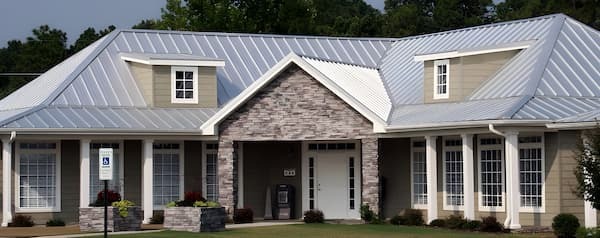
What Are the Most Compatible Fall Protection Products for Union Corrugating Standing Seam Roofs?
Non-penetrating fall protection is critical for Union Corrugating standing seam systems to protect the roof panels and the workers.
Union Corrugating's standing seam profiles rely on hidden clips, floating seams, and thermal expansion to protect the building below. A misplaced screw or the wrong anchorage method can pinch the seam, restrict panel movement, or create a hidden water leak. That is why compatible non-penetrating anchors remain the only safe and responsible choice.
The goal of this blog is to help contractors, installers, and building owners select fall protection that matches the exact seam profile and gauge of Union Corrugating panels. In the following sections, we'll look at each standing seam profile and explain which SSRA products, lifeline kits, and ridge-based anchors offer the safest and most effective setup for installation crews and long-term maintenance teams.
SL150 Panel (SnapLok)
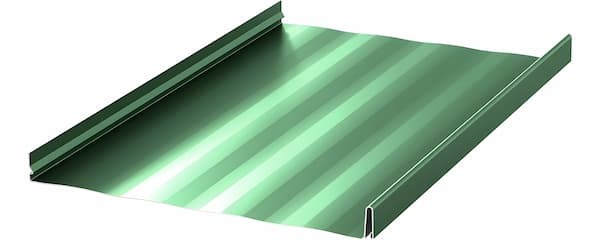
The SL150 panel blends a tall seam with snaplock simplicity to deliver strength, clean lines, and dependable weather performance.
Union Corrugating's SL150 profile is a modern snaplock option that works well on residential roofs, agricultural structures, and light commercial buildings. The panel spans 16 inches with a 1.5-inch rib, creating a sharp vertical shadow line that maintains its shape across long runs. Because the system installs with concealed clips, no fasteners penetrate the metal surface, which helps the roof expand and contract naturally as temperatures rise and fall throughout the year. See the Roof Anchor Compatibility Chart for Union Corrugating Company SL150 Standing Seam Panels.
Contractors can order the SL150 in 24-gauge or 26-gauge steel, and Union Corrugating can fabricate it at the factory or directly on the jobsite when needed. The heavier 24-gauge version offers greater rigidity in high-wind regions or with wider support spacing. The lighter 26-gauge panel works well on simpler residential projects where weight and cost matter more than structural stiffness. The snaplock seam creates a tight, weather-resistant joint without the need for field-seaming tools, giving crews a predictable, efficient installation process.
SL150 panels meet several performance standards, including UL 580 Class 90 uplift resistance, UL 2218 Class 4 impact resistance, and Texas Department of Insurance approvals. These ratings give builders confidence in demanding climates where wind and hail are common.
Fall Protection for SL150 Panels
The SL150, in 24-gauge steel, supports non-penetrating seam anchors, while the lighter 26-gauge version requires a ridge-based tie-off.
On 24-gauge SL150 roofs, crews can tie off using non-penetrating anchors that attach to the rib without interfering with the hidden clip system. The SSRA1 Standing Seam Roof Anchor tightens onto the seam with 12 stainless-steel set screws rather than through-fasteners, providing installers with a certified attachment point that preserves the roof's weather-tight performance.
When workers need a steady platform for trimming, layout work, or staging materials, two SSRA1 anchors can receive SSRA2 Adjustable Roof Jack Adapters. These adapters support a 10-foot walk board and adjust for seam height and roof pitch, keeping the working surface level and helping reduce fatigue and slips on steep metal roofs.
For extended mobility, crews can mount SSRA3 Anchor Plates on top of the SSRA1 anchors. These aluminum plates become the end anchors for temporary horizontal lifelines, including the SSRA HLL 100-Foot Temporary Horizontal Lifeline Kit, which supports two workers while keeping the entire system fully non-penetrating.
Buildings that require frequent rooftop access benefit from installing the Super Anchor 120-Foot Permanent Horizontal Lifeline Kit, which stays mounted year-round and eliminates the need for repeated setup. Maintenance crews clip into a known, OSHA-compliant lifeline the moment they reach the ridge, and the system spreads loads across multiple attachment points without drilling through the SL150 panels.
For 26-gauge SL150 panels, the Ridge Pro Steep Assist Anchor provides a safe alternative. It hooks over the ridge and lets workers clip into a vertical lifeline before stepping onto the panel surface, maintaining a secure tie-off for slopes from 6:12 to 12:12.
SL175 Panel (SnapLok)

The SL175 panel blends architectural style with light structural strength and installs easily using its snaplock standing seam design.
Union Corrugating's SL175 panel gives builders a dependable snaplock option for architectural and light structural roofing. The panel is available in 16-inch and 18-inch widths with a 1.75-inch seam height that locks securely over concealed clips, creating a clean look with strong wind uplift resistance. Installers appreciate the straightforward snap-together design, which eliminates the need for special tools and speeds up field production. See the Roof Anchor Compatibility Chart for Union Corrugating Company SL175 Standing Seam Panels.
This panel is produced in 24-gauge steel and is available in unpainted Galvalume Plus or in Union's Signature 200 and Signature 300 painted finishes. The coated versions pair a high-strength steel substrate with a corrosion-resistant Galvalume layer, and the painted SL175 panels come with a 45-year limited finish warranty. The profile works well in schools, shopping centers, banks, hotels, office buildings, and other projects where long-term durability and refined appearance matter. A minimum roof pitch of 1:12 ensures proper drainage.
Fall Protection for SL175 Panels
Steel SL175 roofs accept non-penetrating seam anchors or ridge-based systems for safe access.
On 24-gauge SL175 installations, the safest tie-off method uses non-penetrating seam anchors that grip the rib without affecting the hidden clip system. The SSRA1 Standing Seam Roof Anchor clamps to the seam using 12 stainless-steel set screws rather than through-fasteners. This attachment method creates a certified tie-off point that protects the panel's shape, finish, and long-term weather performance.
When crews need a level work platform, two SSRA1 anchors can hold SSRA2 Adjustable Roof Jack Adapters. These adapters support a ten-foot walkboard and adjust for both roof pitch and seam height, so workers stand on a stable, level surface on steep roofs.
Large roof sections where workers must move freely benefit from SSRA3 Anchor Plates mounted onto the SSRA1 anchors. These aluminum plates serve as the endpoints for temporary lifeline systems, including the SSRA HLL 100-Foot Temporary Horizontal Lifeline Kit, which supports two workers while keeping the entire system fully non-penetrating.
Buildings that require routine rooftop access can upgrade to long-term protection using the Super Anchor 120-Foot Permanent Horizontal Lifeline Kit. This system remains mounted year-round and gives maintenance personnel a safe, OSHA-compliant lifeline the moment they reach the ridge. The setup eliminates the need for repeated temporary installations and preserves the SL175 panel's weather-tight performance.
For SL175 panels with 6:12 and 12:12 pitch, crews can shift to the Ridge Pro Steep Assist Anchor. This ridge-based system hooks over the peak and lets the worker clip into a vertical lifeline before stepping onto the metal surface. It keeps the entire process non-penetrating and ensures workers stay tied off from ladder to ridge and back again.
ML200 Panel (Mechanically-Seamed)
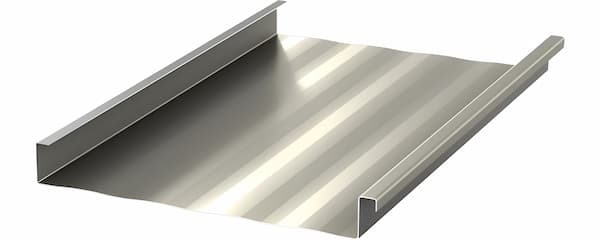
The ML200 panel delivers structural strength with a tall 2-inch rib and a fully seamed profile for demanding commercial environments.
Union Corrugating's ML200 profile gives architects and contractors a strong mechanically seamed option for school roofs, shopping centers, banks, hotels, offices, and other commercial structures where long-term weather performance matters. This system forms a 2-inch vertical rib that increases wind uplift strength and creates a clean architectural appearance. The ML200 can be installed on both open framing and solid substrates, giving designers flexibility across a wide range of building types. See the Roof Anchor Compatibility Chart for Union Corrugating Company ML200 Standing Seam Panels.
The panel attaches with hidden clips, and the interlocking seams are mechanically seamed on-site using standard field seaming equipment. That process creates a continuous double-lock or single-lock seam, depending on project requirements, which improves resistance to high winds and long-term movement. Union Corrugating offers the ML200 in 22-gauge steel, 24-gauge steel, and .032 aluminum. The profile is available in 12, 14, 16, and 18 inches, and panel lengths can reach up to 50 feet, allowing uninterrupted runs over large roof sections.
Installers can apply the ML200 over open framing spaced up to five feet on center, or over solid substrates, including wood sheathing, wood planking, metal decking, or rigid insulation placed over metal decking. The combination of seam height, clip system, and mechanical seaming produces a durable, adaptable roof assembly suited for varied climates and wind exposure zones.
Fall Protection for ML200 Panels
Steel ML200 panels accept non-penetrating seam anchors, while aluminum installations rely on ridge-based tie-off solutions.
On 22-gauge and 24-gauge ML200 panels, the safest tie-off solution uses non-penetrating seam anchors that grip the rib without drilling through the metal. The SSRA1 Standing Seam Roof Anchor locks to the seam using 12 stainless-steel set screws, maintaining the weather-tight performance of the mechanically-seamed profile. It provides a certified attachment point for workers during installation and maintenance.
When crews need a stable platform for staging materials, trim work, or layout tasks, two SSRA1 anchors can support SSRA2 Adjustable Roof Jack Adapters. These adapters hold a ten-foot walk board and adjust for both seam height and roof slope so workers maintain balance on steep metal roof sections.
Projects that require mobility across larger roof areas benefit from SSRA3 Anchor Plates mounted onto SSRA1 anchors. These plates serve as the end anchors for temporary horizontal lifeline systems, including the SSRA HLL 100-Foot Temporary Horizontal Lifeline Kit. That complete system supports two workers and keeps the entire setup fully non-penetrating, which protects the seams and clip system on mechanically-seamed roofs.
Facilities that require routine access for HVAC service, inspections, or equipment upgrades can install the Super Anchor 120-Foot Permanent Horizontal Lifeline Kit. This long-term system stays mounted year-round and gives maintenance personnel immediate OSHA-compliant tie-off points. Permanent lifelines reduce setup time and keep the ML200 panel's double-lock seams untouched.
For aluminum ML200 roofs, crews can deploy the Ridge Pro Steep Assist Anchor on slopes from 6:12 to 12:12. The ridge-based system hooks over the peak and allows the worker to clip into a vertical lifeline before stepping onto the aluminum surface, which eliminates seam attachment and keeps workers tied off from ladder to ridge and back again.
ML150 Panel (Mechanically-Seamed)
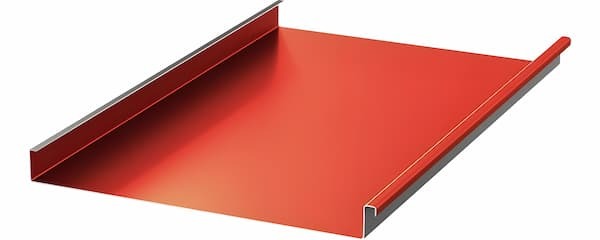
The ML150 panel blends architectural flexibility with a 1.5-inch seam profile that performs well on detailed commercial roof designs.
Union Corrugating's ML150 standing seam system gives contractors an architectural option that handles complex roof layouts without sacrificing long-term performance. The panel forms a 1.5-inch vertical rib and is available in 12, 16, 18, and 20 inches, giving designers plenty of room to match layout spacing, roof shape, and visual style. Union offers the ML150 in 22-gauge and 24-gauge steel and .032 aluminum, depending on project requirements. See the Roof Anchor Compatibility Chart for Union Corrugating Company ML150 Standing Seam Panels.
The ML150 locks together using a field-seamed side lap, mechanically formed with standard seaming equipment. That continuous seam improves wind uplift resistance and gives the panel the strength to withstand seasonal expansion and contraction. The floating clip system helps the panel maintain clean lines across long runs, and the profile can be curved for radius applications when specified. These features make the ML150 a popular choice for entry canopies, curved architectural accents, and commercial projects with multiple elevation changes.
Fall Protection for ML150 Panels
Non-curved steel ML150 panels accept non-penetrating SSRA seam anchors, while aluminum versions require ridge-based tie-off planning.
For 22-gauge and 24-gauge ML150 steel installations, workers can safely tie off using non-penetrating seam anchors that engage the seam without drilling or damaging the panel. The SSRA1 Standing Seam Roof Anchor grips the seam with 12 non-penetrating stainless steel set screws, providing a certified attachment point that preserves the integrity of the mechanically seamed system.
Workers can create a steady work platform by mounting SSRA2 Adjustable Roof Jack Adapters onto two SSRA1 anchors whenever trim work or long panel seaming is required. These adapters support a 10-foot walkboard and adjust for seam height and roof slope, keeping the work surface level and reducing the risk of slips.
Contractors working across extended roof spans can add SSRA3 Anchor Plates above the SSRA1 anchors. These plates serve as the mounting base for temporary horizontal lifeline systems, including the SSRA HLL 100 Foot Temporary Horizontal Lifeline Kit, which supports two workers while keeping every component fully non-penetrating.
For aluminum ML150 roofs, crews can use the Ridge Pro Steep Assist Anchor on slopes from 6:12 to 12:12, allowing workers to connect to a secured vertical lifeline before stepping onto the metal surface. This ridge-based method eliminates seam contact and keeps crews tied off from ladder to ridge.
For curved ML150 applications, a trained fall protection professional should inspect the curved roof system. Radius roofs demand specialized solutions, and choosing the correct method keeps workers safe while preserving the panel's structural performance.
TS-324 Double-Lok Trapezoidal Panel (Mechanically-Seamed)
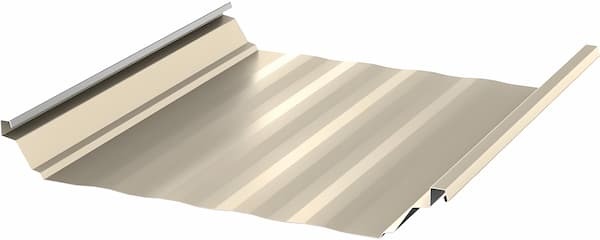
The TS-324 Double-Lok panel delivers high structural strength, a tall 3-inch seam, and long-span capability for low-slope commercial roofs.
Union Corrugating's TS-324 Double-Lok panel is one of the strongest systems in its entire lineup. The profile forms a 3-inch-tall trapezoidal rib and is available in 18-inch or 24-inch coverage widths, giving designers flexibility in balancing structural load requirements and roof layout constraints. The panel attaches with concealed clips and is mechanically field-seamed to create a weather-tight seam capable of handling demanding uplift conditions. See the Roof Anchor Compatibility Chart for Union Corrugating Company TS-324 Standing Seam Panels.
A key advantage of this profile is its ability to perform on ¼:12 roof slopes, which is the lowest minimum pitch among Union Corrugating's standing seam offerings. That capability comes from the panel's deep seam shape and the integrity of the 180-degree mechanical seam. Since the TS-324 works well over open framing, contractors rely on it for warehouses, manufacturing plants, agricultural buildings, and commercial structures that require long spans without solid decking.
Union rolls this panel in 24-gauge steel, and the system can be ordered in lengths up to 50 feet, reducing the number of end laps on large structures.
Fall Protection for TS-324 Double-Lok Panels
Steel TS-324 installations support non-penetrating seam anchors and ridge-based systems to protect workers.
The 24-gauge steel used on TS-324 panels supports the use of non-penetrating seam anchors, which grip the rib without drilling or damaging the concealed clip system. The SSRA1 Standing Seam Roof Anchor remains the primary attachment tool for this profile. Its 12 stainless steel set screws provide secure engagement on the seam while maintaining the panel's weather-tight performance.
When installers need a safe staging point, two SSRA1 anchors can receive SSRA2 Adjustable Roof Jack Adapters. These adapters support a 10-foot walk board and adjust for changes in seam height and roof pitch. This assembly keeps the work surface level and reduces fatigue on steep metal roofs.
For larger roof projects that require worker mobility, crews can add SSRA3 Anchor Plates above the SSRA1 anchors. These plates serve as the mounting base for temporary horizontal lifeline systems, including the SSRA HLL 100 Foot Temporary Horizontal Lifeline Kit, which supports two workers and keeps every anchorage point fully non-penetrating.
Facilities that require routine access for HVAC, utilities, or roof inspections can benefit from installing the Super Anchor 120 Foot Permanent Horizontal Lifeline Kit. This permanent system eliminates repeated setup time, provides year-round tie-off points, and stays entirely non-penetrating to protect the Double-Lok panel system.
On buildings that use TS-324 panels in steeper sections, workers can rely on the Ridge Pro Steep Assist Anchor for slopes from 6:12 to 12:12. This ridge-based tie-off method lets workers connect to a vertical lifeline before stepping onto the metal surface and provides continuous protection from ladder to ridge without contacting the seam.
Slimline Nailstrip Panel (SnapLok)

The Slimline panel delivers a clean architectural look with a low one-inch rib and a fast-install nailstrip system for residential and light commercial roofs.
Union Corrugating's Slimline Nailstrip panel gives builders an attractive standing seam look without the need for separate clips. The panel forms a 1-inch-tall seam and features an integrated fastening groove that accepts screws driven through a slotted flange. Once fastened, the next panel snaps over the flange, hiding the fasteners from view and creating a smooth, uninterrupted appearance across the roof. See the Roof Anchor Compatibility Chart for Union Corrugating Company Slimline Standing Seam Panels.
This nailstrip design allows faster installation for projects that need a streamlined process without sacrificing curb appeal. The Slimline panel covers 16 inches per sheet and requires a minimum roof pitch of 3:12 for proper drainage. Union offers it in 24-gauge or 26-gauge steel, using either unpainted Galvalume Plus or one of their Signature paint systems. Buyers can choose from Signature 200 siliconized polyester coatings on 26-gauge steel or Signature 300 PVDF finishes on 24-gauge steel. Painted versions include a 45-year limited finish warranty, making the panel suitable for residential, light commercial, and agricultural installations where color longevity is essential.
The Slimline system relies on its fastener flange and snap-together ribs, so it does not use concealed clips. This construction gives the panel a low profile and clean architectural look while allowing thermal expansion through the slotted flanges.
Fall Protection for Slimline Panels
Nailstrip panels do not support seam-mounted anchors, so ridge-based tie-off methods provide the safest and most compatible solution.
Because the Slimline Nailstrip profile uses a fastener flange rather than a structural vertical rib, it cannot support seam anchors. For this reason, safety managers should rule out non-penetrating seam anchors, such as SSRA1, SSRA2, and SSRA3, on Slimline projects.
The safest and most compatible method is the Ridge Pro Steep Assist Anchor. This ridge-based system hooks over the roof peak. It allows workers to clip into a vertical lifeline before stepping onto the metal surface. Because it never contacts the seam, it protects the Slimline panel from deformation and preserves its weather-tight performance.
The Ridge Pro works on roof pitches from 6:12 to 12:12, providing installers with a stable anchorage option during layout, fastening, and trim work. It also offers continuous tie-off during ladder transitions, which is especially important on nailstrip projects where seam-mounted systems are not possible.
By choosing ridge-based fall protection systems that match the Slimline panel's fastening method, contractors can work safely without compromising the roof's performance, appearance, or warranty coverage.
Standing Seam Metal Roof Anchor Panel Compatibility Chart For Union Corrugating Company
| SL150 24 Ga. | SL175 24 Ga. | ML200 22 Ga. | ML200 24 Ga. | ML150 22 Ga. | ML150 24 Ga. | TS-324 24 ga. | Slimline | |
|---|---|---|---|---|---|---|---|---|
SSRA 1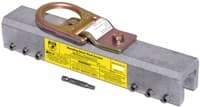 |
NO | NO | YES | NO | YES | NO | NO | NO |
SSRA1 Nylon Tip |
YES | YES | YES | YES | YES | YES | YES | NO |
SSRA2 Roof Jack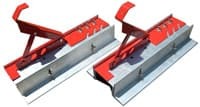 |
YES | YES | YES | YES | YES | YES | YES | NO |
SSRA3 Anchor Plate |
YES | YES | YES | YES | YES | YES | YES | NO |
The Ridge Pro |
YES | YES | YES | YES | YES | YES | YES | YES |
Contact Us for Expert Standing Seam Fall Protection Advice
For expert guidance on standing seam roof anchors, lifeline kits, and fall protection systems that protect both your crew and your panels, contact us today at 863-703-4522 or visit www.StandingSeamRoofAnchor.com. Our safety specialists can help you match the right non-penetrating anchor to your specific roof profile and slope. Let's make your next metal roofing project safe, compliant, and built to last. For continued learning, download OSHA's 48-page Fall Protection Manual and our free Anchor Inspection Form once you've selected the ideal anchors for your roof system. Together, we'll help you stay ahead of OSHA standards while preserving your roof's weather-tight seal.
Safety Tips For Standing Seam Roofs
Use Seam-Compatible, Non-Penetrating Anchors Only
Union Corrugating's standing seam panels rely on concealed clips and natural floating movement, so crews must use non-penetrating anchors to protect the system. The SSRA1 Standing Seam Roof Anchor locks onto approved 24-gauge steel seams with low-torque stainless steel set screws, protecting the SL150, SL175, ML150, and ML200 profiles. Crews should avoid anchors that require locating clips on existing roofs or driving screws into the panel, as these mistakes can deform the seam or endanger workers.
Install Permanent Horizontal Lifelines When Buildings Need Repeat Access
Commercial buildings that use ML200 or ML150 panels often host technicians for HVAC work, rooftop equipment servicing, and periodic inspections. The Super Anchor 120 Foot Permanent Horizontal Lifeline Kit creates a long-term tie-off solution so maintenance teams do not need to reinstall temporary anchors each visit. It provides predictable OSHA-compliant anchor points year after year.
Include Trauma Straps on Every Harness in Service
A successful fall arrest does not end the risk. Without trauma straps, suspended workers may lose circulation within minutes. Trauma straps let a worker take weight off the harness leg straps and maintain blood flow while they wait for rescue. The straps weigh almost nothing, they cost very little, and they pair perfectly with SSRA1 anchors or a Ridge Pro Steep Assist tie-off. Every Union Corrugating job should treat them as standard equipment.
Promote a Safety Mindset at the Start of Every Day
Five minutes of conversation before the crew steps onto an SL150 or SL175 roof can prevent hours of trouble later. Talk through forecast changes, material staging, tie-off locations, and potential rescue procedures. Encourage workers to speak up when conditions shift or when a detail looks unsafe. Conversations like this build trust and sharpen awareness long before the roof work begins.
Build an OSHA-Compliant Safety Plan Before Work Starts
A complete safety plan maps out how workers will access the roof, where anchor points will sit, how horizontal lifelines will route, and who will handle rescue responsibilities. Plans must adapt to the panel type, slope, weather conditions, and crew size. Updating the plan whenever a schedule or layout shift occurs is one of the simplest ways to maintain compliance and prevent improvisation that leads to injuries.
Equip Workers With High-Quality Personal Fall Protection Gear
Union Corrugating roofs require dependable gear that workers trust the moment they clip in. A properly fitted full-body harness, a smooth-operating SRL from the Malta Dynamics Pygmy Hog or Edgehog series, and connectors inspected at the start of each shift give crews confidence before they ever reach the roof. OSHA continues to emphasize proper harness fit and daily inspection, so ongoing training should reinforce those habits.
Use Guardrails and Controlled Access Zones Where Practical
On large commercial installations, such as those using ML200 or TS-324 Double-Lok panels, guardrails are among the most effective preventive measures available. They create visible and physical boundaries around skylights, roof edges, or equipment platforms. When combined with non-penetrating tie-off systems, guardrails help funnel foot traffic into safe zones and discourage risky shortcuts across open roof spans.
Consult a Fall Protection Expert for Curved or Radius Panels
When working on Union Corrugating profiles with radius options, especially the ML150, always have a qualified expert evaluate the roof before selecting an anchor system. Curved panels behave differently under load than straight seams. A competent safety professional can determine whether the Ridge Pro, structural tie-offs, or engineered systems are appropriate. Hence, the panel remains undamaged and fully compliant.
Require Roofing-Grade, Slip-Resistant Footwear
Metal panels can accumulate dust, dew, or metal filings, making them slick without warning. Crews working on SL175 or TS-324 roofs need boots built for metal surfaces with firm ankle support and a grippy, flat rubber sole. Footwear designed for roofing reduces fatigue and provides workers with a steadier footing on metal roofs.
Reinforce Ladder Safety Before Anyone Leaves the Ground
Many roofing accidents occur before the worker even reaches the roof. Workers should inspect ladders for cracks, bent rails, damaged feet, and loose locks. The four-to-one angle rule and three points of contact remain some of the simplest and most effective safety measures on the jobsite. Taking 1 minute to verify ladder setup prevents injuries at the very first step.
Disclaimer
The views, recommendations, and information presented in this blog are solely those of the author and do not necessarily reflect the opinions or positions of the featured panel manufacturer, its brands, subsidiaries, or parent companies. Customers are strongly encouraged to contact the roof panel manufacturer directly for inquiries regarding fall protection compatibility with their products and to address any potential warranty issues that may arise after installing our products.

